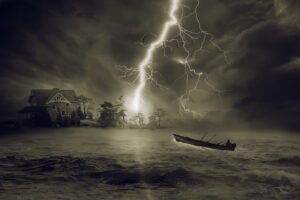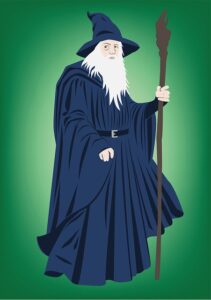Do you want to learn how to write descriptive copy that will dazzle your readers? Good descriptive writing can transport your readers into another world and make them feel right there in the thick of the action.
This blog post will discuss some tips for improving your descriptive writing skills. We will also provide a few descriptive writing examples that will leave you wanting more!
What is descriptive writing, and how does it create suspenseful moments?
Descriptive writing is a powerful tool that authors use to help deepen their reader’s connection with the narrative, characters, and settings. Think of it like painting a picture with words – you want to help your reader visualize what’s happening in the story and bring them closer to its universe.
If you’re writing a thriller novel, descriptive writing is critical as it helps create an atmosphere of tension, suspense, and anticipation for your readers.
Examples of descriptive writing in a thriller can include characters that are described with details that make them appear menacing, descriptions of eerie settings or buildings where the action takes place, or descriptions of natural phenomena (like storms) that add an atmosphere of suspense.
Descriptive words like “murky,” “dreary,” and “desolate” are often used to create heightened tension for the reader. Additionally, similes such as “the shadows were long like tentacles reaching out for her” can add an extra dimension to the narrative by simultaneously engaging visual and auditory senses.
An example of descriptive writing:
“The room was shrouded in darkness; all I could make out were odd shapes and silhouettes as my eyes slowly adjusted to the lack of light. A chill ran down my spine as I heard creaks from each corner from an unknown presence lurking within it.”
Here are some practical steps to craft descriptive writing for your story
– Set aside time before starting your project devoted to a writing description.
– Develop detailed character profiles allowing you greater freedom while crafting scenes.
– Spend time getting familiar with your setting – if possible, travel there to observe its physical features firsthand.
– Practice describing objects around you using accurate terminology – this will help create an atmosphere on paper later.
– Include literal details and imaginative symbolism to captivate readers’ imaginations.
– Think about how sensory details (smell, feel, taste, etc.) may influence a scene rather than just what everything looks like – this helps build suspense.
Start with describing the setting of your story

When writing a thriller novel, descriptive writing can be critical as it sets the mood of suspense and anxiety that readers expect from these types of stories. To achieve this effect, you should try using detailed descriptions of characters, settings, and plot points to create an ominous atmosphere while promising thrilling action later.
How do the surroundings make an impression on the character, and how do they fit into the narrative? Is it in a dark, creepy forest or an abandoned warehouse? Are the walls lined with cobwebs and dusty shelves? These details add to the atmosphere and can help establish a mood.
A truly chilling example of a setting
In Alfred Hitchcock’s classic psychological horror film, Psycho, the Bates Motel beckons viewers into an eerie world of secret pasts and menacing potential threats. Its dark shadows, gothic architecture, and looming presence on the hillside overlooking the swampy countryside below create an unnerving atmosphere that leaves audience members feeling more like victims than voyeurs.
Everything about this scene oozes fear: from Norman Bates’ skittish behavior in his cabin office to the creaky steps leading up to his mother’s bedroom door. Even when nothing out-of-the-ordinary happens – like when Marion Crane stops by for a chat with Norman – viewers can still feel a chill running down their spine as they get glimpses of what could happen should Marion choose not to leave any time soon.
In addition to creating tension through visuals alone, Alfred Hitchcock also used music to ratchet up the level of dread even further: Bernard Herrmann’s iconic score utilizes dissonant orchestral tones that convey feelings of malice; this soundtrack heightens our sense of impending danger with each note heard throughout the entire film. In short, Psycho is perhaps one of cinema’s best examples for demonstrating how powerful audio-visual elements can be used together to create a unique scare-filled environment — one which has been frightening audiences since 1960!
Pay close attention when describing the various places where events take place in your thriller novel. Make sure to include details about smells (burning candles or freshly cut grass), sights (clear blue skies or lush forest landscapes), sounds (waves crashing onto shorelines or babies laughing), etc., which will transport readers into the world you have created.
Describe your characters

Start by crafting physical descriptions that will help your readers become emotionally attached to all your characters – their eyes and hair color, facial features, and expressions; clothing choices; body language – will all add valuable layers of complexity for each character being described. Make sure each detailed description is both accurate and evocative so as add depth not just physically but also emotionally.
Are they brave or timid and scared? Think about how your readers feel as they read – do you want them to feel scared, adventurous, or inspired? Consider what words and phrases will evoke these emotions in your readers.
It’s also important to establish character traits to stand out from one another – motives such as ambition or greed will contribute greatly towards building cliffhanger moments in your story.
Think about how characters look as they move through various scenes and settings. Describing physical traits such as clothing choices or body language can give readers greater insight into individual personalities without needing too many words.
Paint a picture with your words of how the villain looks and what they sound like when they’re creeping up on their victim.
Use sensory details to bring your scenes to life
Can readers smell the stench of rotting flesh or feel the cold, damp air against their skin? What does a scene smell or sound like? What textures are around them, and how do they feel to touch? What does the room smell like? What kind of music is playing in the background? What are the characters wearing, and how do their clothes fit into the atmosphere of the story?
Set the scene with small details such as smells, for example, “the tangy scent of citrus wafted through his senses,” or sounds, “a distant musical laugh caught her ear,” or colors, “she felt something cold trickle down her spine like the icy blue hues on her bedroom walls.”
These types of details can help create an atmosphere where tension hangs heavy in every detail – setting up crucial moments in anticipation throughout your story instead of letting them seem sudden or too convenient when they arrive later.
Sensory details can add another layer of realism to the narrative, further drawing your audience’s attention. For example: instead of just saying, “the room smelled musty,” describe why it was musty (due to water damage from flooding) and what else was lurking behind those odors (old books from the back shelves).
Incorporate imagery

Use metaphors when introducing new scenes, as these are useful for quickly conveying information while engaging your audience simultaneously.
For instance, “The room was filled with shadows like black velvet curtains drawn against moonlight” has a much stronger effect than simply saying, “the room was dark.” Practicing descriptive writing techniques like this can give a graphic element in laying down descriptions.
The “dark cloud” metaphor:
The “dark cloud” metaphor often indicates impending danger or suspense without stating it outright. For instance, after months of investigating, the hero has finally managed to track down the story’s villain. The tension is high, and he knows that anything could happen when they meet face-to-face. The author might use this metaphor to create an atmosphere of suspense:
“As he approached his enemy’s hideout, a dark cloud seemed to hang over him, obscuring his vision with its ominous presence.”
This gives readers an indication that things are about to get dangerous – and allows them to speculate on what might be lurking beneath the surface. It also helps set up expectations for further conflict in the story. It heightens suspense through imagery rather than directly telling readers how they should feel about everything happening in front of them.
Create foreshadowing elements
This comes under strong imagery but also requires careful consideration when used effectively within thrillers, as these tropes require precise planning without giving away too much information too early on.
Examples could be hints of death looming throughout conversations between two people who turn out to be connected by tragedy later, making these allusions feel eerily prescient.
Or, if you’re reading a thriller about an oncoming storm and one of the characters says, “It’s going to be a terrible night” early on in the story, this foreshadows that something bad will happen at night. The reader can interpret this as something physical (like rain or wind) or abstract (like a break-in or murder).
Consider adding dialogue tags whenever possible
Dialogue tags act like written vocal cues for each character, making conversations between them more natural.
Here is a scene in Stephen King’s novel The Shining:
“I’m scared,” Wendy said quietly.
Jack snarled his response: “You ought to be!”
As you can see here, Stephen King has employed two distinct dialogue tags for each speaker, which reflect their roles very well – Wendy is scared, so her line is whispered. In contrast, Jack’s demeanor is the opposite as he aggressively snaps at her.
Pay attention to the dialogue between characters – decide which phrases fit each character best without cluttering up scenes too much; think about how specific sentences could add even more tension than what is written – leaving out long pauses after someone speaks becomes its own type of violence!
And finally, don’t forget those experiences that cannot necessarily be understood fully in words yet still mean something important – allow yourself space to get creative here!
When done right, dialogue can create lively tension between characters, adding mystery. When incorporating dialogue into descriptions, make sure you pay attention to body language and intonation, which will enhance interactions between characters more realistically. Hence, readers stay engaged throughout the scene(s).
Keep your readers hooked by using suspenseful language and cliffhanger endings

Let readers know the stakes and create tension in your scenes by making them anticipate what could happen next. Cliffhangers are an important and exciting literary device that adds suspense to stories.
A cliffhanger is essentially a narrative hook; its purpose is to leave the reader in a state of suspense, wanting more. It typically occurs at the end of a chapter, episode, or book. It can involve a range of plotlines, from simple questions about what will happen next to dangerous situations with uncertain outcomes for one or more characters.
An example of a cliffhanger:
In JRR Tolkien’s The Lord of the Rings: The Return of the King, Frodo Baggins stands on the brink of Mount Doom, ready to cast away The One Ring into Mordor’s volcanic pits, when Gollum suddenly attacks him! Will he survive this encounter? Will he succeed in his mission? We had to wait until the next installment or movie viewing session to find out!
Please keep it simple
Overall, descriptive writing is an essential part of any novelist’s toolkit, which can easily make their stories captivatingly immersive if done correctly, which applies to thriller writing too.
Don’t bog down your scenes with too much detail or unnecessary words; use vivid language, suspenseful elements, and metaphors to help your readers connect with the story and its characters.
Conclusion
Following these steps can create suspenseful and thrilling descriptive writing for your novel. These tips will help you bring your story to life and keep readers hooked, making sure there’ll be plenty more thrills waiting for both yourself and future fans alike 😉
If you’re working on your first novel and are looking for more help with your writing, please check out my other articles on writing at https://ullahakanson.com/blog/
Thanks for reading!
All the best,
Ulla

